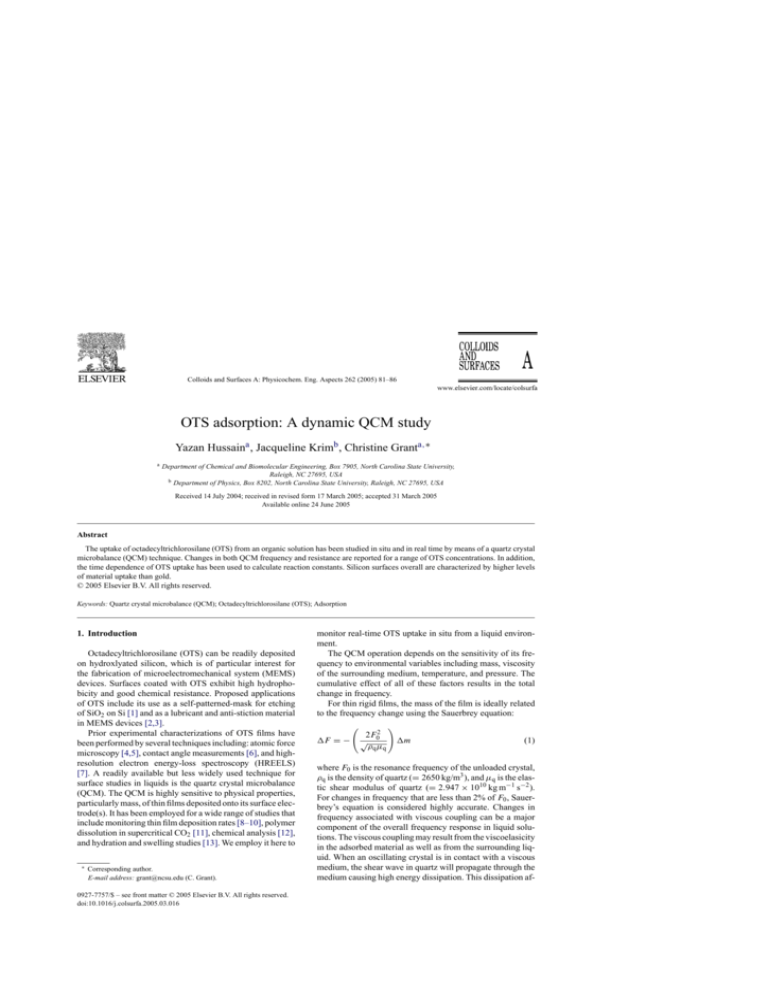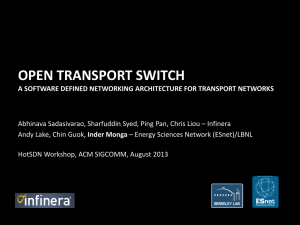
Colloids and Surfaces A: Physicochem. Eng. Aspects 262 (2005) 81–86
OTS adsorption: A dynamic QCM study
Yazan Hussaina , Jacqueline Krimb , Christine Granta,∗
a
Department of Chemical and Biomolecular Engineering, Box 7905, North Carolina State University,
Raleigh, NC 27695, USA
b Department of Physics, Box 8202, North Carolina State University, Raleigh, NC 27695, USA
Received 14 July 2004; received in revised form 17 March 2005; accepted 31 March 2005
Available online 24 June 2005
Abstract
The uptake of octadecyltrichlorosilane (OTS) from an organic solution has been studied in situ and in real time by means of a quartz crystal
microbalance (QCM) technique. Changes in both QCM frequency and resistance are reported for a range of OTS concentrations. In addition,
the time dependence of OTS uptake has been used to calculate reaction constants. Silicon surfaces overall are characterized by higher levels
of material uptake than gold.
© 2005 Elsevier B.V. All rights reserved.
Keywords: Quartz crystal microbalance (QCM); Octadecyltrichlorosilane (OTS); Adsorption
1. Introduction
Octadecyltrichlorosilane (OTS) can be readily deposited
on hydroxlyated silicon, which is of particular interest for
the fabrication of microelectromechanical system (MEMS)
devices. Surfaces coated with OTS exhibit high hydrophobicity and good chemical resistance. Proposed applications
of OTS include its use as a self-patterned-mask for etching
of SiO2 on Si [1] and as a lubricant and anti-stiction material
in MEMS devices [2,3].
Prior experimental characterizations of OTS films have
been performed by several techniques including: atomic force
microscopy [4,5], contact angle measurements [6], and highresolution electron energy-loss spectroscopy (HREELS)
[7]. A readily available but less widely used technique for
surface studies in liquids is the quartz crystal microbalance
(QCM). The QCM is highly sensitive to physical properties,
particularly mass, of thin films deposited onto its surface electrode(s). It has been employed for a wide range of studies that
include monitoring thin film deposition rates [8–10], polymer
dissolution in supercritical CO2 [11], chemical analysis [12],
and hydration and swelling studies [13]. We employ it here to
∗
Corresponding author.
E-mail address: grant@ncsu.edu (C. Grant).
0927-7757/$ – see front matter © 2005 Elsevier B.V. All rights reserved.
doi:10.1016/j.colsurfa.2005.03.016
monitor real-time OTS uptake in situ from a liquid environment.
The QCM operation depends on the sensitivity of its frequency to environmental variables including mass, viscosity
of the surrounding medium, temperature, and pressure. The
cumulative effect of all of these factors results in the total
change in frequency.
For thin rigid films, the mass of the film is ideally related
to the frequency change using the Sauerbrey equation:
F = −
2F02
√
ρ q µq
m
(1)
where F0 is the resonance frequency of the unloaded crystal,
ρq is the density of quartz (= 2650 kg/m3 ), and µq is the elastic shear modulus of quartz (= 2.947 × 1010 kg m−1 s−2 ).
For changes in frequency that are less than 2% of F0 , Sauerbrey’s equation is considered highly accurate. Changes in
frequency associated with viscous coupling can be a major
component of the overall frequency response in liquid solutions. The viscous coupling may result from the viscoelasicity
in the adsorbed material as well as from the surrounding liquid. When an oscillating crystal is in contact with a viscous
medium, the shear wave in quartz will propagate through the
medium causing high energy dissipation. This dissipation af-
82
Y. Hussain et al. / Colloids and Surfaces A: Physicochem. Eng. Aspects 262 (2005) 81–86
fects the frequency and the quality factor (Q), which can be
quantified by measuring the change in the crystal resistance.
In addition, changes in bulk and local viscosity can cause frequency changes. The relationship between medium viscosity
(η) and resistance (R) was developed by Klavetter et al. [14]:
1/2
π
ρη
R=
(2)
8K2 C0 πF0 µq ρq
where K2 is the quartz electromechanical coupling coefficient (= 7.74 × 10−3 ), C0 is the static capacitance of the
crystal (= 4.25 pF), and ρ and η are the density and viscosity
of the liquid. Similarly, the relation between the change in
viscosity and F is [15]:
1/2
F03
F = −
(ρη)1/2 .
(3)
πµq ρq
A more complete analysis can be attained by measuring
the acoustic impedance, which is usually performed by means
of an impedance analyzer. Alternatively, it is possible to estimate the change in the crystal’s impedance through analysis of frequency and resistance measurements. Lucklum and
Hauptmann related the frequency shift, F , and resistance
shift, R, to the acoustic load impedance using the following
approximations [16]:
F
Im(ZL )
=−
F
πZcq
(4)
Re(ZL )
R
=
2ωL
πZcq
(5)
where ZL is the acoustic load impedance, Zcq is the characteristic impedance of the quartz, ω (= 2πF ) is the radial
frequency, and L is the motional inductance of the unloaded
crystal in the equivalent circuit. The authors calculated the
impedance for different rubbery coatings in liquids with different viscosities. For example, a coating having a storage
modulus (G ) of 106 Pa, a loss modulus (G ) of 105 Pa, and a
thickness of 100 nm immersed in 1 cP Newtonian liquid will
have an impedance of ca. 8 + j6300 Pa s m−1 . The acoustic
load of the liquid alone is ca. 5600 + j5600 Pa s m−1 . The
value of L for the crystals used in this study was assumed
to be 30 mH. Such analysis can be used to study the interfacial slippage of the adsorbed film [17]. Further details on
the quartz crystal oscillator and its operation can be found
elsewhere [18–20].
No prior studies of OTS uptake by means of QCM were
found in literature. The most relevant work is that by Ruehe
et al. [21] for the deposition of mono- and dichlorosilanes on
Au surfaces. This paper presents a real-time study of OTS deposition from organic solvent onto both Si and metal coated
QCM crystals. Both the frequency and resistance changes
of the crystal in the liquid phase solution are evaluated. The
overall objective is to provide information about the interactions and changes that occur on and close to the surface during
uptake on materials of interest to MEMS applications.
Fig. 1. Experimental setup.
2. Materials and method
2.1. QCM apparatus
Polished grade, 5 MHz, AT-cut QCM crystals obtained
from Maxtek Inc. were used. A Teflon holder, also obtained
from Maxtek, Inc., provided mechanical support and an electrical connection to drive the crystal. The holder allowed only
one side of the crystal to be exposed to liquid. The crystals
consisted of 2.5 cm diameter quartz disks upon which a thin
layer of metal (either 1000 Å Si or 3400 Å Au) was vacuum
deposited onto the liquid exposure side (1.3 cm diameter). A
gold electrode (0.64 cm diameter), which was not exposed to
the liquid, was deposited onto the reverse side of the crystal.
A VC oscillator, obtained from Maxtek, was used to drive
the crystal. The circuit provides two outputs: frequency and
voltage. A frequency counter and a multimeter were used for
frequency and resistance measurements. A schematic of the
setup is shown in Fig. 1.
2.2. Experimental technique and materials
OTS (90%+), chloroform and hexadecane (99%+ anhydrous grade), dodecanethiol, and ethanol were obtained from
Aldrich. The OTS was stored under vacuum. All materials
were used as received without further purification.
Prior to each run, crystals were thoroughly washed with
running water then rinsed with DI water, immersed in 0.05 M
NaOH solution (∼30 min), treated with UV/O3 for 30 min,
immersed in ethanol (∼30 min), and, finally, treated again
with UV/O3 . The second UV/O3 treatment is to remove the
remaining traces of contaminants and to generate the required
hydroxylated surface [22]. This procedure was adopted with
modification from previous work by Brzoska et al. [23].
After cleaning, crystals were immediately mounted in the
holder and immersed in a solution of hexadecane and chloroform (4:1 by volume, as described in [2]). The solution
was placed in a 250 ml Teflon beaker whose temperature was
regulated to 20 ± 0.05 ◦ C. Both frequency and voltage were
Y. Hussain et al. / Colloids and Surfaces A: Physicochem. Eng. Aspects 262 (2005) 81–86
Fig. 2. Change in frequency for 5 MHz Si crystals upon injection of OTS
(10 mM). The arrow indicates injection time. Insert is an enlargement of the
region indicated by the box, to show the stability level.
recorded throughout the duration of the experiment. When
the frequency signal reached a stable level (within 1–2 Hz as
shown in the inset of Fig. 2), between 10 and 6000 l of OTS
was injected into 200 ml solution, yielding a concentration
range up to 80 M. Frequency and voltage shifts were monitored throughout this process, and the run was ended when
the frequency reached a new stable level. The difference between the two stable signals before and after injection was
taken as F .
3. Results and discussion
A representative plot of the QCM data for the adsorption
of OTS on Si is shown in Fig. 2. The figure depicts three
characteristic features of the data acquisition and analysis
process. First, the frequency signal in the solution was stable
to within 1–2 Hz for more than 30 min. Second, the frequency
decreased almost immediately after OTS injection indicating
fast adsorption on the surface. Finally, the frequency limits
used to determine F are noted on the figure.
Over the range of OTS concentrations studied, the values
of F ranged from 150 to 550 Hz. Using Eq. (1), this corresponds to a mass change of 1–5 g, or 10–50 monolayers
if a density of 20 Å2 per OTS molecule is assumed [24]. Although the OTS molecule with its inactive methyl endgroup
is not expected to form multilayers, physical adsorption on
the surface can occur [25,26]. Experimentally these excess
deposits are usually removed by rinsing with fresh solvent before analyzing the sample [23]. Physical adsorption will have
an effect on the frequency as well as the resistance through
energy dissipation, as will be discussed later in this paper.
The high reactivity of OTS can affect the reproducibility of
QCM results [21]. Our approach to this issue was as follows:
first, the measurements were performed over a wide range
83
Fig. 3. Comparison of the change in frequency and resistance between: (1)
dodecanethiol on Au from ethanol, (2) OTS on Si from C16 H34 :CHCl3 , and
(3) OTS on Au from C16 H34 :CHCl3 . All runs were performed at 20 ◦ C.
of concentrations to observe the general behavior. Second,
repetition of a few randomly selected runs was done. Finally,
the results from OTS are compared with other systems. The
systems compared here were selected so that the reactivity
of the molecule and the adsorbent–surface interaction were
substantially different from the OTS/Si system. They include
dodecanethiol (C12 H25 SH) uptake on Au from ethanol solution and OTS on Au with similar conditions to the OTS/Si.
The results are shown in Fig. 3. For completeness, quantitative results are presented in this paper to compare different
substrates and adsorbents in the same experimental system.
Any attempt to compare absolute values of frequencies and
F values in another system must take into account differences in the experimental setup.
As can be seen from Fig. 3, using OTS on Si gave higher
frequency and resistance changes than thiol and silane on
Au surfaces. This is expected since the OTS is more reactive
than the thiol. In the thiol-Au system, the interactions occur
between the molecules and the surface, unlike OTS where
the molecules are highly reactive to each other. Therefore,
OTS is expected to cause larger changes in QCM response
by forming a complex network on the surface which interacts
with the molecules in the solution.
In contrast to the OTS/Si system, the adsorption of OTS
on Au gave significantly lower frequency and resistance
changes. This is also expected since the Au surface has less
active sites (oxygen atoms) due to the inherent instability of
the Au oxide layer, in contrast to that of Si (Note: Au–O bond
strength is about 222 kJ mol−1 compared to 800 kJ mol−1 for
Si–O [27]). From this observation it can be concluded that
that the changes in the solution properties are not the main
factor affecting the QCM response.
The frequency change (F ) as a function of OTS concentration is shown in Fig. 4. It is interesting to note that
at higher OTS concentrations F tends to decrease instead
of reaching a plateau. This may be due to the stronger interaction between OTS molecules at higher concentrations
84
Y. Hussain et al. / Colloids and Surfaces A: Physicochem. Eng. Aspects 262 (2005) 81–86
Fig. 4. Change in frequency for 5 MHz Si coated crystal upon deposition of
OTS film from C16 H34 :CHCl3 (4:1 by volume) at different OTS concentrations.
which inhibits its free movement in the solution, causing less
interaction with the crystal surface.
The above results suggest that the high affinity of Si surfaces to OTS molecules is inducing large changes in the vicinity of the surface. The nature of these changes and the extent
that they interact with the surface are more difficult to address.
However, calculating the acoustic impedance of the crystal
can be used for this purpose by comparing the magnitudes of
the real and imaginary parts of the impedance.
3.1. Acoustic impedance
The value of the complex acoustic impedance (ZL ) can
provide insight into the nature of changes affecting the QCM.
Lucklum and Hauptmann [13] theoretically calculated the
impedance for a 5 MHz QCM crystal coated with 1 m polymer films with different shear moduli. Their analysis suggests
that a film in the glassy state will have low values for the real
and imaginary parts of ZL , whereas in the rubbery state the
film will have a significant influence on both parts.
As shown in Fig. 5, both the imaginary and real parts have
high values. According to the above discussion, this indicates
a high viscous effect from the surrounding medium, which is
translated into an increase in the viscosity of the region close
to surface. This can be concluded by comparing the OTS/Si
and OTS/Au systems. It is also evident from Fig. 5 that the
imaginary part is slightly larger than the real part. This fact
is expected since OTS does form a film on the Si surface.
3.2. Adsorption kinetics
Fig. 5. Impedance diagram for the OTS coated crystals as calculated using
Eqs. (4) and (5). OTS concentrations are indicated next to the points.
ics of alkanethiols adsorption [28,29]. Our evaluation begins
with the premise that OTS adsorption follows a Langmuir
mechanism. This mechanism involves a two step diffusion–
adsorption process, where diffusion is assumed to be the limiting step in the case of OTS [6]. For such a mechanism, the
reaction rate can be written as [6]:
φ(t) =
β
[1 − exp (−αt)]
α
where φ is the fraction of free active sites on the surface,
α = Cb kaf + kar and β = Cb kaf . The parameters α and β can
be obtained by fitting the frequency to Eq. (6). An example of
QCM data with its theoretical Langmuir fit is shown in Fig. 6.
From the relation between α and Cb , the values of kar and kaf
were determined, see Fig. 7. The results of the reaction rate
calculations, the equilibrium constant (Keq = kaf /kar ), and
free energy of adsorption (G = −RT ln Keq ) are shown in
Table 1.
The large scatter in the data in Fig. 7 may be due to two factors. First, the frequency response may not be solely due to the
OTS adsorption. It is also possible that the adsorption occurs
in a short time interval of the frequency change, while the rest
of the changes are due to viscous coupling effects. Second,
the ideal assumption of Langmuir adsorption may need to be
modified. As can be seen in Fig. 6, the frequency-time relation results in a relatively good fit to the experimental data.
However, the behavior of F with increasing concentration
Table 1
Kinetic and thermodynamic constants for OTS adsorption calculated from
the QCM results assuming a Langmuir-type mechanism using Eq. (6)
Constant
The time-dependent frequency data can be used to study
the adsorption kinetics. We will assume that the decrease in
the resonance frequency represents the adsorption process,
an approach that was used previously to study the kinet-
(6)
(mM s−1 )
kaf
kaf (s−1 )
Keq (mM−1 )
Gads (kcal/mol)
Value
0.14
0.001
140
−7
Y. Hussain et al. / Colloids and Surfaces A: Physicochem. Eng. Aspects 262 (2005) 81–86
85
The crystal resistance was coupled with frequency change to
calculate the impedance of the deposits. The imaginary part
of the impedance was comparable to the real part, a situation
that can be compared to a rubbery polymer film. Finally, the
reaction kinetics were determined by fitting the frequencytime data to Langmuir isotherm. The forward reaction rate
constant is four orders of magnitude higher than the reverse
constant.
Acknowledgements
This work was supported in part by Grant No. CMS0087866 from the National Science Foundation and in part
by a grant from the AFOSR No. F49620-01-1-0132 (JK).
Fig. 6. Frequency response for 5 MHz Si QCM crystal after injection of OTS
to a final concentration of 1 mM.
Fig. 7. Determination of rate constants for OTS absorption at 20 ◦ C. The
parameter α(= Cb kaf + kar ) was determined by fitting as discussed in the
text.
(Fig. 4) does not follow this equation. Therefore, it may be
necessary to modify the mechanism to take into account the
effect of high OTS bulk concentrations.
4. Conclusion
The adsorption of OTS on Si surface was studied by measuring the change in QCM frequency and resistance, and
the results were compared with thiol/Au and OTS/Au systems. The frequency shift associated with OTS adsorption
on Si from hexadecane-chloroform solution was greater than
200 Hz. This shift is much larger than that observed with dodecanthiol. This may be explained by the presence of high
viscous coupling near the surface, or the attachment of a slippery film of OTS to the surface. This was concluded from the
decrease in the frequency shift at higher OTS concentrations.
References
[1] T. Komeda, K. Namba, Y. Nishioka, Octadecyltrichlorosilane selfassembled-monolayer islands as a self-patterned-mask for HF etching
of SiO2 on Si, J. Vacuum Sci. Technol. A: Vacuum Surf. Films 16 (3)
(1998) 1680–1685.
[2] U. Srinivasan, M.R. Houston, R.T. Howe, R. Maboudian, Alkyltrichlorosilane-based self-assembled monolayer films for stiction reduction in
silicon micromachines, J. Microelectromech. Syst. 7 (2) (1998) 252–
260.
[3] U. Srinivasan, R.T. Howe, R. Maboudian, Lubrication of polysilicon
micromechanisms with alkylsiloxane self-assembled monolayers, in:
B. Bhushan (Ed.), Tribology Issues and Opportunities in MEMS, Proceedings of the NSF/AFOSR/ASME Workshop held in Columbus,
Ohio, 1998, pp. 597–606.
[4] T. Balgar, R. Bautista, N. Hartmann, E. Hasselbrink, An AFM study of
the growth kinetics of the self-assembled octadecylsiloxane monolayer
on oxidized silicon, Surf. Sci. 523–535 (2003) 963–969.
[5] C. Carraro, O.W. Yauw, M.M. Sung, R. Maboudian, Observation
of three growth mechanisms in self-assembled monolayers, J. Phys.
Chem. B 102 (1998) 4441–4445.
[6] K. Efimenko, B. Novick, R.G. Carbonell, J.M. DeSimone, J. Genzer,
Formation of self-assembled monolayers of semifluorinated and hydrocarbon chlorosilane precursors on silica surfaces from liquid carbon
dioxide, Langmuir 18 (16) (2002) 6170–6179.
[7] G.J. Kluth, M. Sander, M.M. Sunga, R. Maboudian, Study of the
desorption mechanism of alkylsiloxane self-assembled monolayers
through isotopic labeling and high resolution electron energy-loss spectroscopy experiments, J. Vaccum Sci. Technol. 16 (3) (1998) 932–
936.
[8] F. Caruso, T. Serizawa, D.N. Furlong, Y. Okahata, Quartz crystal microbalance and surface plasmon resonance study of surfactant adsorption onto gold and chromium oxide surfaces, Langmuir 11 (5) (1995)
1546–1552.
[9] T.H. Ha, K. Kim, Adsorption of lipid vesicles on hydrophobic surface
investigated by quartz crystal microbalance, Langmuir 17 (6) (2001)
1999–2007.
[10] A. Weerawardena, C.J. Drummond, F. Caruso, M. McCormick, Real
time monitoring of the detergency process by using a quartz crystal
microbalance, Langmuir 14 (3) (1998) 575–577.
[11] Y.-T. Wu, P.-J. Akoto-Ampaw, M. Elbaccouch, M.L. Hurrey, S.L.
Wallen, C.S. Grant, Quartz crystal microbalance (QCM) in highpressure carbon dioxide (CO2 ): experimental aspects of QCM theory
and CO2 adsorption, Langmuir 20 (9) (2004) 3665–3673.
[12] J. Wang, M.D. Ward, R.C. Ebersole, R.P. Foss, Piezoelectric pH sensors: AT-cut quartz resonators with amphoteric polymer films, Anal.
Chem. 65 (19) (1993) 2553–2562.
86
Y. Hussain et al. / Colloids and Surfaces A: Physicochem. Eng. Aspects 262 (2005) 81–86
[13] M.T. Colberg, K. Carnes, A.E. Saez, C.S. Grant, K. Hutchinson, D.
Hesterberg, Hydration of phospholipid films in aqueous environments,
Colloids Surf. 153 (3) (1999) 483–495.
[14] E.A. Klavetter, S.J. Martin, K.O. Wessendorf, Monitoring jet fuel thermal stability using a quartz crystal microbalance, Energy Fuel 7 (1993)
582–588.
[15] S.J. Martin, V.E. Granstaff, G.C. Frye, Characterization of a quartz
crystal microbalance with simultaneous mass and liquid loading, Anal.
Chem. 63 (20) (1991) 2272–2281.
[16] R. Lucklum, P. Hauptmann, The f -R QCM technique: an approach to an advanced sensor signal interpretation, Electrochim. Acta
45 (2000) 3907–3916.
[17] J. Ellis, G. Hayward, Interfacial slip on a transverse shear mode acoustic
wave device, J. Appl. Phys. 94 (2003) 7856–7867.
[18] V.E. Bottom, Introduction of Quartz Crystal Unit Design, Van Nostrand
Reinhold electrical/computer science and engineering series, Van Nostrand Reinhold Company, 1982.
[19] D.A. Buttry, M.D. Ward, Measurement of interfacial processes at electrode surfaces with the electrochemical quartz crystal microbalance,
Chem. Rev. 92 (6) (1992) 1355–1379.
[20] C. Lu, A.W. Czanderna, Applications of piezoelectric quartz crystal microbalances, Methods and Phenomena: Their Applications in Science
and Technology, vol. 7, Elsevierff, 1984.
[21] J. Ruehe, V.J. Novotny, K.K. Kanazawa, T. Clarke, G.B.
Street, Structure and tribological properties of ultrathin alkylsilane
[22]
[23]
[24]
[25]
[26]
[27]
[28]
[29]
films chemisorbed to solid surfaces, Langmuir 9 (1993) 2383–
2388.
A. Ulman, An Introduction to Ultrathin Organic Films: From Langmuir-Blodgett to Self-Assembly, Academic Press, San Diego, 1991.
J.B. Brzoska, I.B. Azouz, F. Rondelez, Silanization of solid substrates: A step toward reproducibility, Langmuir 10 (11) (1994) 4367–
4373.
F. Schreiber, Structure and growth of self-assembling monolayers,
Progress Surf. Sci. 65 (5–6) (2000) 151–256.
L. Netzer, R. Iscovici, J. Sagiv, Adsorbed monolayers versus
Langmuir–Blodgett monolayers—why and how? I. From monolayer
to multilayer, by adsorption, Thin Solid Films 99 (1983) 235–
241.
W.R. Ashurst, C. Yau, C. Carraro, C. Lee, G.J. Kluth, R.T. Howe, R.
Maboudian, Alkene based monolayer films as anti-stiction coatings
for polysilicon MEMS, Sens. Actuators, A: Phys. A91 (3) (2001) 239–
248.
D.R. Lide (Ed.), CRC Handbook of Chemistry and Physics [electronic
resource], third ed., Knovel, Norwich, NY, 2001.
D.S. Karpovich, G.J. Blanchard, Direct measurement of the adsorption
kinetics of alkanethiolate self-assembled monolayers on a microcrystalline gold surface, Langmuir 10 (1994) 3315–3322.
H. Kima, S. Kwak, Y. Kim, B. Seo, E. Kim, H. Lee, Adsorption kinetics of alkanethiols studied by quartz crystal microbalance, Thin Solid
Films 327–329 (1998) 191–194.







